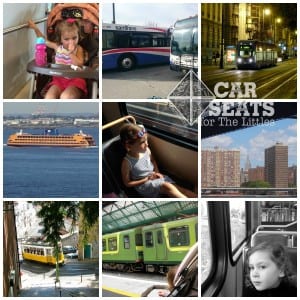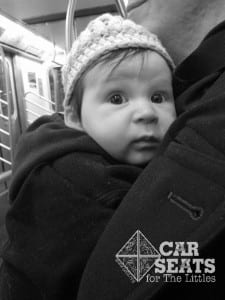 Urban kids have all the fun! At least if you’ve got kids like mine who love big machines. When we lived in a rural area and traveled, getting to and from museums and parks was half the fun of the trip. We rode on subways, light rail, city buses, and even ferries — they were all part of the adventure. Now that we live in a big city, we get to ride these awesome vehicles to get to doctors appointments, school, play dates, and even the park!
Urban kids have all the fun! At least if you’ve got kids like mine who love big machines. When we lived in a rural area and traveled, getting to and from museums and parks was half the fun of the trip. We rode on subways, light rail, city buses, and even ferries — they were all part of the adventure. Now that we live in a big city, we get to ride these awesome vehicles to get to doctors appointments, school, play dates, and even the park!
Safety
 I’ll admit it: public transportation might be less fun for those of us who can’t watch a Thomas the Tank Engine episode 15 times in a row. But it’s easy to stay safe and keep our Littles safe when moving around the city. Generally speaking, non-car urban transportation is much safer than taking the car, so any time you can skip the car or taxi with Littles you’re making the safer choice. On any form of transport that doesn’t have seat belts, there is no way to use a car seat, so if you are carrying a car seat it will need to be stowed. On any form of transport that has seat belts, you’ll want to bring and install a proper restraint for the size of the child.
I’ll admit it: public transportation might be less fun for those of us who can’t watch a Thomas the Tank Engine episode 15 times in a row. But it’s easy to stay safe and keep our Littles safe when moving around the city. Generally speaking, non-car urban transportation is much safer than taking the car, so any time you can skip the car or taxi with Littles you’re making the safer choice. On any form of transport that doesn’t have seat belts, there is no way to use a car seat, so if you are carrying a car seat it will need to be stowed. On any form of transport that has seat belts, you’ll want to bring and install a proper restraint for the size of the child.
Subways and Urban trains
Statistically speaking, trains are a very safe mode of transportation. Trains do not have seat belts for installing child restraints. They are large, visible, only go in one direction and are centrally controlled. Subways are particularly safe — unlike ground transport, they don’t cross busy streets.
The New York City subway system is the busiest in the United States and one of the busiest in the world, serving almost 6 million rides every weekday. Passenger injuries and fatalities even on this complex and busy system are very rare, and those who are killed or injured are most likely to be people struck by trains. In 2015 in New York City, 172 people were struck by subway trains, and 50 were killed. This means that teaching children good track-side safety is key to keeping your little travelers safe: slow down on stairs, hold handrails, stay with an adult, and do not stand on or near the yellow platform edge.

Safe in a seat
When you’re riding on a subway, ideally you’ll find a seat for your Littles and yourself before the train takes off. Babies can ride in a lap or be worn.
Some subways will require you to fold a stroller, while you’ll be able to wheel a stroller right on to others. Since a stroller has wheels it may be more convenient to take a small child out of the stroller and hold him or her; lock the wheels if the stroller is not folded up and possibly place it perpendicular to the direction of travel. I often block my stroller with my body to keep it from rolling away. If kids are riding in the vestibule of a subway, remind them to hold on to poles and take a nice wide stance to avoid falling when the train speeds up and slows down.
Buses
City buses are also very safe forms of transit: they are very large and visible, they take pre-determined routes, they are driven by trained operators and they usually move at slower speeds than other vehicles on the road. In a crash with a smaller vehicle, just by virtue of its size, a bus is less likely to transfer impact to its passengers than a car would be.
In bus accidents the driver is most likely to be injured; a seat away from the very front of the bus is likely the safer place to ride. Always sit if possible on city buses; children can have their own seats or sit in an adult’s lap. Infants can be worn or held.
When I travel by city bus with a wiggly 2 year old I prefer the seats that are in the middle of the bus, facing the front. I have my child sit in the window seat and I sit in the aisle. That way if he gets bored and stands up he’s still contained by the seat in front of him and me on the aisle side. When sitting with a child in the sideways seats in the front or back of a bus the kids tend to flop toward the front and back of the bus when the bus stops and starts; it takes a lot more work to keep a young child in those seats.

Babywearing AND stroller!
Some city buses will require that strollers be folded to ride, others will allow you to roll a stroller on to the bus. As in a subway or train, the wheels on a stroller can cause it to move around, so it might be best to remove children from the stroller and hold them on your lap. In any event, remember to lock the stroller’s wheels and keep a hand on it at all times.
As with trains, paying extra attention to boarding and leaving a bus safely is essential: the most dangerous part of the ride is when you are a pedestrian. Never run for a bus, stand back as the bus approaches the curb, and check the road before you step off. Always hold children’s hands securely when boarding or leaving a city bus.
Light Rail, Trolleys, and Street Cars
Trains that travel on the road with cars may be more unpredictable in terms of braking and turning than a subway, but these systems, like other urban transport systems, are very safe and do not require a car seat. Boarding these trains can be more like boarding buses, however, and again, caregivers need to be extra careful with children as they board and disembark into traffic. As always, grab a seat for your Little if possible and hold on!
Ferries

Go by boat!
Those of us who live in a city with urban ferries are the luckiest commuters of all: ferries are a safe and beautiful way to get from one point to another. All urban ferries will be equipped with life jackets, and they will be well marked: my kids like to play “find the mustard station” (a muster station is the place on a ship where you gather in an emergency).
Boarding a ferry is another moment when children need to be monitored and taught good dock-side safety: drowning is, like traffic accidents, a leading cause of childhood death. Any time Littles are around water caregivers need to be aware of the danger of falling in. Active urban ferries are also big machines with many moving parts: it’s important to make sure children stay far from the areas where the ferry operators are working. Look around you when boarding a ferry: there are often well-marked areas where passengers must not stand when the boat is docking as well as areas on the outside decks where a small toddler could be injured. Like all transit, sitting in the seat while the craft is moving is the safest way to travel.
Moving around a city without a car is safe and a lot of fun. So park the car and go explore!




